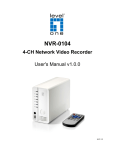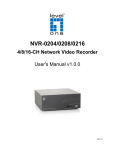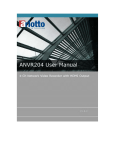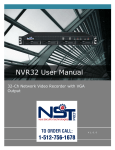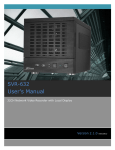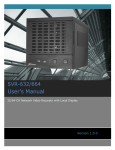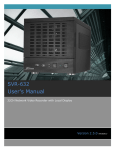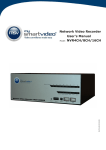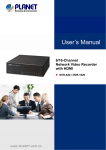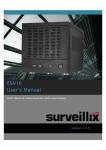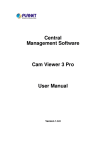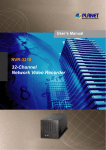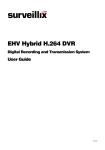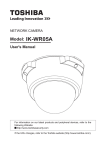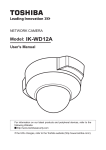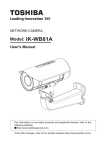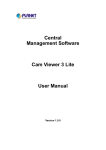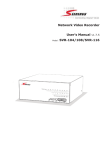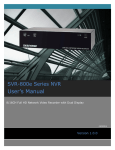Download ESV4 Operation Manual
Transcript
ESV4
User’s Manual
4CH Network Video Recorder with Local Display
Version 1.0.0
2
ESV4 User’s Manual
Table of Contents
System Overview...................................................................... 5
Front View .....................................................................................
Rear View ......................................................................................
Part names ....................................................................................
LED Definition ................................................................................
5
6
7
7
Installation............................................................................... 8
HDD Installation ............................................................................. 8
Connect to the NVR ...................................................................... 13
Use Device Search Utility................................................................13
Access the NVR with its default IP address........................................ 17
Set up Password............................................................................18
Camera Installation ...................................................................... 19
Add a Camera -- Automatic Search .................................................. 19
Add a camera manually ..................................................................21
Live View (Web Interface) ..................................................... 22
Live View ...................................................................................... 22
Retrieve camera’s video stream ...................................................... 22
Retrieve camera’s status ................................................................23
Perform Sequence Viewing ............................................................. 23
PTZ Control ..................................................................................25
Perform PTZ Preset Viewing ............................................................ 26
Preset Point Viewing ......................................................................27
Auto Pan Viewing ..........................................................................27
Preset Point Sequence Viewing ........................................................ 28
Live Video Controls ........................................................................28
Display ratio and full screen ............................................................ 29
Take a snapshot of a live video ....................................................... 29
Perform Digital PTZ .......................................................................33
Adjust Brightness for the Live Video................................................. 35
Adjust Contrast for the Live Video ................................................... 36
Change Web UI Display Language ................................................... 37
Live View through iPhone Safari Browser .......................................... 38
Live View through Blackberry Phones ............................................... 41
Playback (Web Interface) ...................................................... 45
Playback ....................................................................................... 45
Methods to Search Playback Videos ................................................. 45
Search by time chart .....................................................................46
Search by event ............................................................................47
Play by specific time ......................................................................49
Search by event (Most Recent) ....................................................... 50
Certain functions you can perform to the playback video .................... 51
Take a snapshot of a playback video ................................................ 52
Adjust Brightness for the Playback Video .......................................... 56
Adjust Contrast for the Playback Video ............................................. 57
ESV4 User’s Manual 3
Export Playback Videos to AVI Files ................................................. 57
Play Exported Playback Videos with NVR Media Player ........................ 61
Open Event Snapshot images with NVR Media Player ......................... 63
NVR Setup -- System Configurations (Web Interface) ............ 63
Network Setup ............................................................................. 63
Network Settings ...........................................................................64
DHCP Server .................................................................................65
DDNS Service ...............................................................................66
Time and Date .............................................................................. 72
User Account ................................................................................ 73
Add a new user .............................................................................74
Change the password of the “admin” account ................................... 75
Group Privilege ............................................................................. 76
Disk Setup .................................................................................... 78
NVR Setup -- Channel Configurations (Web Interface) ........... 79
Add a camera ............................................................................... 79
Automatic Search ..........................................................................79
Add a camera manually ..................................................................84
OSD Settings ................................................................................ 85
PTZ Setting ................................................................................... 87
PTZ Preset Settings .......................................................................87
PTZ Preset Sequence .....................................................................88
E-Map Setting ............................................................................... 90
Local Map Setting ..........................................................................90
Google Map Setting .......................................................................92
NVR Setup -- Event Configurations (Web Interface) .............. 94
Event Configuration ...................................................................... 94
General Settings ...........................................................................95
DI Settings ................................................................................... 97
Event Servers ............................................................................... 98
Configuring an FTP server...............................................................98
Configuring an SMTP server .......................................................... 100
Event Triggers ............................................................................ 101
NVR Setup -- Recording Configurations (Web Interface)...... 102
General Settings ......................................................................... 102
General Settings ......................................................................... 103
Schedule Recording .................................................................... 107
To configure a schedule recording ................................................. 107
NVR Setup -- System Options (Web Interface) ..................... 108
Device Information..................................................................... 108
Device Information ...................................................................... 109
Logs and Reports ........................................................................ 110
Maintenance ............................................................................... 111
Reboot the NVR at a specific time automatically .............................. 112
Firmware Upgrade ....................................................................... 112
4
ESV4 User’s Manual
Through the web interface ............................................................ 112
Upgrade through USB thumb drive ................................................ 114
Reset the NVR to Factory Default .................................................. 115
Disk Status ................................................................................. 116
USB Backup ................................................................................ 117
Things to pay attention to the USB Backup function ......................... 118
Play the backup file with the NVR Media Player ............................... 119
Local UI from HDMI Output .................................................. 123
Live View .................................................................................... 123
Login screen ............................................................................... 123
Remote control ........................................................................... 125
Live View.................................................................................... 128
Side menu .................................................................................. 129
Sequence view ............................................................................ 134
PTZ Control ................................................................................ 138
Add preset points ........................................................................ 138
Preset point sequence view........................................................... 139
Manual Recording ........................................................................ 141
Take snapshot ............................................................................ 143
PIP (Picture-in-picture) Event Video ............................................... 145
Turn on Audio ............................................................................. 146
Full Screen ................................................................................. 147
Display video in its original size ..................................................... 148
Detail channel status ................................................................... 149
Dashboard .................................................................................. 151
Power off .................................................................................... 152
Playback ..................................................................................... 153
Time Chart ................................................................................. 155
Export recorded data ................................................................... 157
Camera Setup ............................................................................. 159
Specifications ....................................................................... 168
Technology license Notice .................................................... 170
About the software ...................................................................... 170
ESV4 User’s Manual 5
System Overview
Front View
6
ESV4 User’s Manual
Rear View
ESV4 User’s Manual 7
Part names
Audio
Lineout
NTSC
LED Definition
8
ESV4 User’s Manual
Installation
HDD Installation
Locate the screws highlighted above on the back of the NVR.
Use a Philips screwdriver to release the screws.
ESV4 User’s Manual 9
Slide open the case as shown above.
One side of the housing can be detached as shown above.
10
ESV4 User’s Manual
Install the top HDD by attaching it to the corresponding SATA cable
first.
Make sure the HDD is securely attached.
ESV4 User’s Manual 11
Place the HDD to the tray and make sure the screw holes on the HDD
are aligned with the ones on the tray.
Secure the HDD with the screws provided in the accessory box with a
Philips screwdriver. There are four for each HDD; two for each side of
the tray.
12
ESV4 User’s Manual
Slide the side housing back to the unit.
Secure the housing with the screws highlighted above.
NOTE:
Maximum capacity of each hard disk drive is 3TB.
Do not use hard disk drives with power saving functions such as
Intellipower.
For a list of compatible hard disk drives, visit
www.toshibasecurity.com.”
ESV4 User’s Manual 13
Connect to the NVR
There are various ways you can connect to the NVR and below are the
suggested methods for different network setup:
Through the browser from another PC on the network:
• The NVR is placed in a network with a DHCP server: Connect to the
NVR by using “NVR Device Search” Utility
• The NVR is placed in a network without DHCP server (or you are
connecting to it directly): Access the NVR with its default IP
Use Device Search Utility
If the NVR is placed in a corporate network or a local area network
where a DHCP server is already presented, run the “NVR Device
Search” utility from a computer that is on the same network and locate
the NVR with its IP address that is assigned by the top-level DHCP
server.
14
ESV4 User’s Manual
To begin, launch the “NVR Device Search” utility from the CD and
proceed with the installation:
ESV4 User’s Manual 15
Once the installation is complete, check the “Launch the Search AP”
option and click “Finish”.
The search should start automatically and its status should be displayed.
The NVR should be located and its IP address should be displayed.
16
ESV4 User’s Manual
Double-click on an NVR and the search program should automatically
access the NVR’s web administration page from your default browser.
You will be prompted for the NVR’s username and password. Enter its
default username “admin” and password “admin” and then click “OK”
to enter the system.
•
•
Please make sure you are using Internet Explorer 7 or above (IE
10 is NOT yet supported).
If you are running Windows Vista or 7, please make sure you are
running Internet Explorer with the “administrator” privilege.
ESV4 User’s Manual 17
Access the NVR with its default IP address
The NVR comes with a pre-configured static IP “192.168.101.50”.
However, it is only used when there is no DHCP server presented in
the network. The NVR will turn on its DHCP server function and act as
the DHCP server in the network. To connect to the NVR, use a PC that
is on the same network over a switch or hub, or connect the PC
directly to the NVR using a crossover CAT5 Ethernet cable.
The PC that is connected directly to the NVR (or within the same local
area network) should receive an IP from the NVR. Simply access the
NVR from your web browser with its IP address
18
ESV4 User’s Manual
Again, you should be prompted for the username and password. Enter
its default username “admin” and password “admin” and then click
“OK” to enter the system
Set up Password
The default login username and password is admin/admin. To change
the password of the admin account, go to “Setup” --> “System Configurations” --> “User Account”, click on the “admin” account in the
account list then press the “edit” button to change its password.
Finally, click “Apply” to save the change.
ESV4 User’s Manual 19
Camera Installation
Add a Camera -- Automatic Search
Click the “Search” button to perform the camera search.
You should be prompted to install Active Control component in order
for the search to function properly. Go ahead and click “Install”
After that, the search should begin and its status should be displayed:
20
ESV4 User’s Manual
Found cameras should be listed and simply select a camera from the
list and press “Configure”
Its corresponding information should be displayed in the “Camera
Information” section. Enter its username and password and select the
channel ID and name the camera.
ESV4 User’s Manual 21
Click on “Detect” to establish connection between the recorder and the
camera. If a connection is established successfully, the camera’s
detailed information will be displayed as below.
Adjust its video format, frame rate, resolution or bit rate...etc if you
wish and then click “Add” to finish adding the camera
Add a camera manually
Simply follow the instruction described above but instead of using the
“Search” function, enter the camera’s IP address and credential in the
“Camera Information” manually.
22
ESV4 User’s Manual
Live View (Web Interface)
Live View
The “Live View” page provides the following functions:
•
•
•
•
•
•
•
•
•
•
Retrieve camera’s video stream
Retrieve camera’s status
Perform Live Sequence Viewing
PTZ Control
Perform PTZ Preset Sequence viewing
Perform manual recording
Take snapshot
Receive audio of a video stream
Send audio
Change web UI display language
Retrieve camera’s video stream
The camera list is expanded and displayed on the Live View
page:
•
Click “All” to display videos of all 4 channels
•
Click on any camera individually to display video in single-view
mode
ESV4 User’s Manual 23
Retrieve camera’s status
The camera list can show each camera’s current status. Each status is
represented with different colors:
Blue: Connected
Gray: Disconnected
Red: Performing event recording
Green: Recording (manual/continuous/schedule)
White: This channel is not configured with any camera
Perform Sequence Viewing
24
ESV4 User’s Manual
Sequence view is a function that allows you to view multiple video
streams from certain cameras in sequence automatically without
having to select them one by one. To perform sequence view, select
“SEQ View” from the upper-left hand corner
Next, select one or more camera(s) or camera group(s) for sequence
viewing:
Select "all" to start sequence viewing in quad view
Select "camera" individually to start sequence viewing in single video
view
Then, select dwell interval from the drop-down menu and click "Start"
to begin.
ESV4 User’s Manual 25
PTZ Control
PTZ control provides functions to pan, tilt, and zoom a PTZ camera as
well as the ability to adjust camera focus and iris.
Only PTZ capable cameras will be listed in the drop-down menu
26
ESV4 User’s Manual
The bar highlighted above controls the moving angle. Larger number
means bigger movement angle.
Perform PTZ Preset Viewing
There are three functions provided in the “Preset” section:
•
Perform preset point viewing of a particular camera
•
Auto pan a particular camera
•
Perform preset point sequence viewing
(In order to use this function, one must configure camera's preset
points in "NVR Setup" >> "Channel Configurations" >> "PTZ Preset"
first)
ESV4 User’s Manual 27
Preset Point Viewing
Start by selecting a PTZ camera from the drop-down list
Its available PTZ preset points will be listed in the drop-down list
shown below. Click "Go to" to move to the selected position.
Auto Pan Viewing
28
ESV4 User’s Manual
Use the Auto Pan control buttons to pan right, left and stop auto pan
* Certain cameras do not support bi-directional pan movements.
Use the “Auto pan” button for such cameras
Preset Point Sequence Viewing
This function allows you to view multiple preset points from a video of
a camera without having to select them one by one. Once you have
defined the preferred preset points in “Channel Configurations” >>
“PTZ Setting” >> “PTZ Sequence” under the “Setup” menu, click
“Start” in the lower-left hand corner in Live View under “Preset” and
the recorder will begin to display videos from those preset points in
sequence automatically until you click “Stop”
Live Video Controls
Users can perform certain functions to a live view video. They can be
accessed by right clicking on a video.
ESV4 User’s Manual 29
Display ratio and full screen
By default, the videos are set to fill the whole video window, to display
its original size or ratio, use the button in the upper-right hand corner.
Take a snapshot of a live video
To take a snapshot of a live video, right-click on the video and select
"Take Snapshot". You are given with options to take 1 snapshot or 3
continuous snapshots.
30
ESV4 User’s Manual
The new window displays the snapshot.
ESV4 User’s Manual 31
If the "3 continuous snapshots" option is chosen, the new window
displays snapshots and lets you view them individually by using the
"Prev", "Next" buttons shown above.
32
ESV4 User’s Manual
However, as soon as a snapshot selection is made, the snapshots are
automatically saved to x:\SnapshotFolder ("x" represents the partition
where Windows is installed, e.g.: C:\)
You can right-click anywhere on the image and select "Save Picture
As..." to save the images somewhere else if you wish.
ESV4 User’s Manual 33
A dialog should be displayed that allows you to choose a
directory/folder of where the snapshot will be saved to.
Perform Digital PTZ
34
ESV4 User’s Manual
To perform digital PTZ on a particular channel, right-click anywhere on
its video and select "Digital PTZ".
Next, hold the mouse left button and draw a square on the video to
specify the zoom in area
ESV4 User’s Manual 35
Once the image is digitally zoomed in, use the mouse scroll button to
further zoom on or zoom out the image. Hold and left-click on the
image and move the mouse to move the zoomed in video.
Adjust Brightness for the Live Video
You are able to adjust brightness of the live video from the right-click
menu.
36
ESV4 User’s Manual
Adjust Contrast for the Live Video
Same thing as the brightness, you can set the contrast for the live
video from the right-click menu as well.
ESV4 User’s Manual 37
Change Web UI Display Language
You can change the web UI display language from the current login
username link located at the upper-right hand corner. Click on the link
opens up a new window which displays detail information about the
user as well as a drop-down menu which lets you change the display
language.
38
ESV4 User’s Manual
Live View through iPhone Safari Browser
You can use iPhone and perform single channel live view to the NVR by
using its Safari browser. To be able to view the live video through the
Safari browser, make sure “javascript” is on under “Settings” >>
“Safari” >> “Javascript”
Once Javascript is enabled, click the “Home” button on the iPhone to
go back to the home screen and open the Safari browser
ESV4 User’s Manual 39
Type in the IP address of the NVR in the address bar
You should be prompted to enter the username and password to
access the NVR
40
ESV4 User’s Manual
Upon successful login, you should see the live view video of the first
channel
Click on the “Channel” drop-down menu to select other cameras
ESV4 User’s Manual 41
If a PTZ camera is selected, the corresponding control buttons will
display (control PT only)
* Please note that this function is camera dependent and is not
available to all cameras. Certain cameras do not allow adjusting image
size and the se- lection “Auto” will be used.
Live View through Blackberry Phones
You can use Blackberry and perform single channel live view to the
NVR by using its Safari browser. To be able to view the live video
through its browser, make sure “javascript” is enabled under “Browser”
>> “Menu button” >> “Options” >> “Browser Configuration”
42
ESV4 User’s Manual
Enable the “Support Javascript” option and click the menu button and
click “Save Options”
Go to “General Properties
Make sure two options illustrated above are enabled
ESV4 User’s Manual 43
Press the menu button and click the “Save Options” to save settings
Press the button highlighted above to go back to the browser
44
ESV4 User’s Manual
Type in the IP address of the NVR in the address bar
You should be prompted to enter its username and password for
access
ESV4 User’s Manual 45
Playback (Web Interface)
Playback
Playback is a function that allows you to play one or more videos that
were previously recorded by a chosen recording method or due to an
event trigger. The NVR offers synchronized playback from up to 4
channels and various types of search methods are provided to help
you find the footage you need quickly.
You can turn on or off the audio of a recorded video at your choice if
audio was also recorded during the recording of the video.
Playback video can be viewed in full screen and snapshots can be
taken and saved during a video playback.
Methods to Search Playback Videos
The NVR offers three methods to quickly help users find videos that
were previously recorded:
•
•
•
•
Search by time: Specify a time range and search videos
recorded within that range
Search by event: Find videos that were recorded due to event
triggers
Most Recent Events: Displays the most recent 15 events
Play by start time: Enter a specific time a video was recorded to
start playing back the video
46
ESV4 User’s Manual
Search by time chart
1. Start by selecting which channel(s) you would like to perform a
search on.
2. Select “Search by time chart” from the “Search Method” drop-down
list and click “Go” to start the search
* Selected channels will be marked in red
Results will then be displayed in a new dialog with a “Month/Channel”
table and boxes marked in dark gray represent videos found in those
dates. (* Videos from other cameras that are recorded on the same
date will also be displayed)
ESV4 User’s Manual 47
Clicking on a cell box marked with gray will take you to the "day" view
of the selected month. Repeating the same step will eventually take
you to the "second" view (5sec per cell box). Right-click anywhere or
the "Back" button on the table will take you back to the previous view.
Click on the play button at anytime will start playing videos from the
beginning of the current time view (ex. if the table is in the "month"
view, click play will start playing from the first available clip of that
month)
Search by event
Start by selecting which channel(s) you would like to perform a search
on.
Select “Search by event” from the “Search Method” drop-down list and
click “Go” to start the search
48
ESV4 User’s Manual
Results will then be listed like what is shown below (displays the oldest
record top down). Click on a particular result to start the playback. (*
You can click “Next Search” to display the next 15 results.)
ESV4 User’s Manual 49
You may also specify a new start time to search and display results
from then on. You can restrict the number of results to be displayed at
once (max. 30) and perform the search again
Play by specific time
If you know when a recording was taken place, you may choose the
“Play by start time” from the “Search Method” drop-down list
Then you will be prompted to enter a specific time and date for the
recorded video.
50
ESV4 User’s Manual
Search by event (Most Recent)
This function quickly displays the most recent event recordings from
the selected channels, displaying the most recent result top down.
You may click “Update” to update the list to display the most recent
results.
ESV4 User’s Manual 51
Certain functions you can perform to the playback video
You can do the followings by right clicking on the playback video:
1.
2.
3.
4.
5.
6.
Play Audio
Snapshot
Export as AVI file
Digital PTZ
Adjust Brightness
Adjust Contrast
52
ESV4 User’s Manual
Take a snapshot of a playback video
To take a snapshot, right-click on the video and select "Take
Snapshot". You are given with options to take 1 snapshot or 3
continuous snapshots.
A new window should display and load the snapshot image.
ESV4 User’s Manual 53
The new window displays the snapshot.
54
ESV4 User’s Manual
If the "3 continuous snapshots" option is chosen, the new window
displays snapshots and lets you view them individually by using the
"Prev", "Next" buttons shown above.
ESV4 User’s Manual 55
However, as soon as a snapshot selection is made, the snapshots are
automatically saved to x:\SnapshotFolder ("x" represents the partition
where Windows is installed, e.g.: C:\)
You can right-click anywhere on the image and select "Save Picture
As..." to save the images somewhere else if you wish.
56
ESV4 User’s Manual
Adjust Brightness for the Playback Video
You are able to adjust brightness of the playback video from the rightclick menu.
ESV4 User’s Manual 57
Adjust Contrast for the Playback Video
Same thing as the brightness, you can set the contrast for the
playback video from the right-click menu as well.
Export Playback Videos to AVI Files
User can export the recorded playback videos stored on the NVR to a
local computer and save them in AVI file format. The files can then be
58
ESV4 User’s Manual
played on the PC by a 3rd party media player such as VLC player or
Windows Media player.
Once you locate the recorded videos with steps described in the
previous section, select "Export as AVI file"
A new dialog will pop up and allows you to specify the time frame (or
length) of the video you wish to export
ESV4 User’s Manual 59
You can alternatively choose to export the recorded video to JPEG
images by choosing the "Export as JPEG images" option.
Specify the Start time/End time (or export length) and click "Start" to
begin exporting.
You will be notified once the process is completed successfully
60
ESV4 User’s Manual
The best way to view the exported video or JPEG images is to use the
NVR media player, which can be obtained from the same dialog
window. Simply click on the icon at the bottom (highlighted above),
and a message box should appear to let you open the media player
directly, or save it to the local hard drive for later use.
ESV4 User’s Manual 61
The exported AVI files (or JPEG images) will be saved under the C
partition (or the partition where Windows is installed)
* ffdshow is required in order to play the exported AVI file with
Windows Media Player. You can get it at
http://sourceforge.net/projects/ffdshow/
Play Exported Playback Videos with NVR Media Player
You can also use the NVR Media Player to play the exported AVI files.
This can save you the trouble of installing third-party media player or
codecs when playing the exported AVI videos.
The NVR Media Player will be automatically installed after the CMS
software is installed. You can find it in the Windows Start menu.
Click “Open” >> “AVI File”
62
ESV4 User’s Manual
Locate the exported AVI file, and click “open”. (Normally under
“C:\ExportFolder)”
The video will then start playing
ESV4 User’s Manual 63
Open Event Snapshot images with NVR Media Player
The NVR sends snapshots that are taken when an event occurs to a
destined FTP server or mail recipient. These types of snapshot images
are saved in a proprietary image file format, h4i or p4i, and can only
be opened by the NVR media player.
To do so, Select “Open” from the top menu then select “Image File”. A
new dialog should be displayed which lets you locate the image file.
NVR Setup -- System Configurations (Web
Interface)
Network Setup
The “System Configurations” page provides users options to setup the
device quickly and properly. After properly configuring all settings in all
the sub-pages, users should expect a fully working network video
recorder that is ready to manage cameras on the network. We will
start by configuring its network settings to make sure it works
correctly in your network. Next, we will help you adjust the system
time so videos will be recorder with correct timestamp. To better
secure the system for unwanted disturbance, we will guide you on
setting up user’s account and privileges to prevent settings gets
altered by users other than the system administrator. Lastly, we will
tell you what you should expect after installing a hard disk and how to
prepare the hard disk for the video recording.
64
ESV4 User’s Manual
Network Settings
You need to adjust settings in this page for the device to work properly
in your network. It is critical that settings here are configured correctly
based on your network configurations so that the recorder can be
administered through the local area network and cameras can be
connected from it.
By default, the recorder is set to "Auto Mode" which if there's a DHCP
server in the same local network, the NVR can obtain IP address from
DHCP server, and you can locate the NVR by using the NVR search
utility.
If there's no DHCP server in the network, and the NVR is set to use
"Auto Mode", it will use its own default static IP 192.168.101.50.
The NVR supports three connection types that can be configured
depends on how the network is setup.
ESV4 User’s Manual 65
If you wish to set the recorder to use a static IP address in your local
area network,
1. Choose “Static IP” from the “Connection Type” drop-down menu
2. Enter the IP address, subnet mask, default gateway address and
DNS server address for the recorder
3. Enable “DHCP Server” under “DHCP Server” if you wish to use the
recorder as a DHCP server, or leave it disabled if there is already a
DHCP server in the network
4. Click Apply for the settings to take effect
* The recorder can detect the presence of a DHCP server upon startup.
It sets itself to use static IP address if there is no DHCP server
currently presented in the network. Its DHCP server function is also
turned on at the same time to assign IP addresses to cameras that are
later connected to the network or you can manually turn off the DHCP
server function from "System Configurations">>"Network
Setup">>"DHCP Server" if you wish to use a separate DHCP server
DHCP Server
The built-in DHCP Server function is NOT always configurable and is
greatly dependant to the connection type that is set to use in "Device
Network Setting":
66
ESV4 User’s Manual
1. If the connection type is "Auto Mode", the DHCP server function is
NOT configurable. It will be ON if the NVR doesn't obtain an IP from a
DHCP server in the local network and uses its own default static IP
192.168.101.50
2. If the connection type is "Auto Mode", the DHCP server function is
NOT configurable. It will be OFF if the NVR obtains an IP from a DHCP
server in the local network.
3. If the connection type is "DHCP Client", the DHCP server function is
NOT configurable. It will be OFF if the NVR obtains an IP from a DHCP
server in the local network.
4. If the connection type is "DHCP Client", the DHCP server function is
NOT configurable. It will be ON if the NVR doesn't obtain an IP from a
DHCP server in the local network and uses its own default static IP
192.168.101.50
5. If the connection type if "Static IP", the DHCP server function is
configurable and can be turn on/off manually.
DDNS Service
DDNS, which stands for “Dynamic DNS”, is a method, protocol, or
network service that provides the capability for a networked device,
such as a router or computer system (in this case, the NVR) using the
Internet Protocol Suite, to notify a domain name server to change, in
real time, the active DNS configuration of its configured hostnames,
addresses or other information stored in DNS.
A popular application of dynamic DNS is to provide a residential user’s
Internet gateway that has a variable, often changing, IP address with
a well known hostname resolvable through standard DNS queries.
ESV4 User’s Manual 67
This is useful if the NVR is placed on the Internet with a dynamic
public IP, which once the DDNS is properly setup, users can access the
NVR remotely with the DDNS domain name without worrying if the IP
has changed or not.
*Please make sure a valid DNS server has been configured under the
“Network Setting” page in order for this function to work properly.
*The NVR currently only works with free DDNS service provided by
“DynDNS”. For more information, please go to www.dyndns.com
*If the NVR is placed behind a router or Internet gateway, please
make sure port forwarding for port 80 is configured on the router or
the gat- way in order for the DDNS function to properly register with
the service. It’s often suggested to use the DDNS function in the
router/ gateway for such case instead.
*Once you have the DDNS function successfully up and running,
please DO NOT forget to configure port forwarding for the NVR web
port (default 80) and the streaming port (default 9877) in the
router/gateway for remote viewing. You can then type in
http://yourddnsdomain in the browser to access the NVR remotely for
live view.
68
ESV4 User’s Manual
In order to properly configure the DDNS service function, please
register a free DDNS domain name and account from DynDNS first. Go
to http://dyn.com/dns/dyndns-free/ from the browser to do so.
ESV4 User’s Manual 69
Fill in the necessary fields as illustrated above
The page will check whether another user has used the hostname you
entered or not as soon as you click the “Add to Cart” button. If you see
below message, simply enter a different and click “Add to Cart” again
70
ESV4 User’s Manual
Once you get to the next page, fill in the necessary fields as illustrated
above
ESV4 User’s Manual 71
Go back to the NVR’s DDNS service configuration page under “Setup”
>> “System Configuration” >> “DDNS Service”.
Fill in the domain name you picked during the registration in the
“Domain Name” field and the username/password you created in the
“User ID” and “Password” field and click “Apply” to finish
You can click the “Check DDNS Status” button to check the DynDNS
service status. If you are getting a “Disconnected” message, it means
that DDNS service server is down or the NVR is not connected to the
Internet. If everything is ok normally, you should be prompted with a
success message.
72
ESV4 User’s Manual
Time and Date
Set the time and date by selecting the time zone according to your
location. It is imperative that you set the recorder’s time correctly to
avoid the following errors:
• Incorrect display time for playback videos
• Inconsistent display time of event logs and when they actually occur
After selecting the time zone, choose an option below to set the
recorder time
• Manual – Use the drop-down list and configure the time manually
• Sync with NTP server – enter the hostname or IP address of a
valid NTP server and set how often the recorder should synchronize
the time with it by using the “Update interval” drop-down menu
• Sync with PC – Check this option to synchronize the recorder time
with the PC that you are currently using to access the recorder
ESV4 User’s Manual 73
User Account
Multiple users can access the recorder simultaneously. You can add,
remove, and edit users by using options provided in this page to keep
user information organized. Each recorder comes with a built-in
“admin” account with password “admin”. It’s highly recommended to
change the password upon your initial login.
74
ESV4 User’s Manual
Add a new user
• Enter a username and password in “User Account Information”. All
other fields are optional for your own reference.
• Select a group from the “Group” drop-down menu to assign the new
user to a particular group • Enter a short description for the account if
you wish
• Click “Add” to finish configuration
ESV4 User’s Manual 75
Change the password of the “admin” account
1. Click and highlight the “admin” account in the account list and click
“Edit”
2. Its information should be displayed in “User Account Information”
3. Enter a new password in the “Password” field and enter it again in
“Confirm Password”
76
ESV4 User’s Manual
Group Privilege
Group Privilege is where you can create multiple customized access
policies for situations if you need the recorder to be accessed by users other than the administrator. You can do so by creating a group,
and then remove access privileges for certain configuration pages or
cameras. Users that are created and assigned to this group will have
limited access instead of full administration rights.
The recorder comes with seven built-in groups and five built-in
privilege profiles, except the “admin” and the “guest” accounts; the
other five groups are fully customizable or you can simply assign a
group with one of the default privilege profiles. You can, however,
assign more than one users to the “admin” account if you wish to do
so. The guest account comes with a “view-only” privilege in the “Live
View” page, and users in this group do not have the power to make
any changes in the “Live View” page or have access to pages other
than the “Live View” page.
To create a group, select a group from the “Group” drop-down
ESV4 User’s Manual 77
You can change the group name by clicking the “Change Group Name”
button. A text box will be displayed for you to enter the new group.
Choose what type of privilege you would like this group to have from
the “Privilege Type” drop-down menu.
Its access privilege will then be displayed. You can alter its settings by
allowing or denying access to other cameras using the checkboxes
instead of accepting the defaults
78
ESV4 User’s Manual
Disk Setup
Once you install a hard disk to the recorder, you would need to
initialize it so that it can be ready for recording. You can obtain basic
information about the disk you installed in this page.
To initialize it, simply click the “Format” button.
*This page will list the internal disks only. The HDD will be formatted
in EXT3 file system.
*Maximum capacity of each internal hard disk drive is 3TB.
*The USB HDDs will only be listed in the "USB Backup" and "Hard Disk
Status pages in "System Options". The USB HDDs have to be
formatted in advance in FAT16/FAT32 or EXT3 file system. (FAT32 is
recommended)
ESV4 User’s Manual 79
NVR Setup -- Channel Configurations (Web
Interface)
Add a camera
The NVR provides two options for adding a new camera. Users have
the option to let the recorder automatically find the cameras or it is
possible to enter camera’s information and add it manually.
Automatic Search
Click the “Search” button to perform the camera search.
80
ESV4 User’s Manual
You should be prompted to install Active Control component the first
time you visit the page in order for the search to function properly. Go
ahead and click “Install”
Once you have the ActiveX component installed, the search status
should be displayed after clicking "Search"
Found cameras should be listed and simply select a camera from the
list and press “Configure”
ESV4 User’s Manual 81
Its corresponding information should be displayed in the “Camera
Information” section. Enter its username and password and select the
channel ID and name the camera.
Click on “Detect” to establish connection between the recorder and the
camera. If connection establishes successfully, camera’s detailed
information should be polled and displayed as below.
Adjust its video format, frame rate, resolution or bit rate...etc if you
wish. You can also click on the “Preview” to preview the live video of
the camera.
Click “Add” to finish adding the camera
82
ESV4 User’s Manual
*If cameras are marked with "*" in the search result, it means those
cameras are already configured and connected to the NVR.
Once the camera's settings are polled and displayed, you can also
enable "continuous" recording and adjust its recording quality settings
before adding the camera.
Some cameras are capable of multiple streaming profiles, in which
different video codecs are used for different purposes.
ESV4 User’s Manual 83
You will be able to use different video format for continuous recording
if it's a multi-stream capable camera.
There are two types of fps settings here, one is the fps that NVR sets
back to the camera, and this is the fps NVR will be receiving from the
camera. The other is recording fps, which will be limited by the live fps.
(ex. if the live fps is set to 10, choosing "Full" in the recording fps
meaning it will only record at 10fps maximum.
For MPEG/H.264, only i frame or full (i+p frame) can be selected for
recording fps.
For single stream camera, only the recording fps can be adjusted.
84
ESV4 User’s Manual
Add a camera manually
Simply follow the instruction described above but instead of using the
“Search” function, enter the camera’s IP address and credential in the
“Camera Information” manually.
ESV4 User’s Manual 85
OSD Settings
The OSD (On Screen Display) allows users to add informational text
message and embed it onto the video. By default, this function is
turned off. To add texts to one or more videos:
Select a camera you would like to add text to and choose “Display OSD”
Choose one or more display options if you would also like the recorder
to automatically embed the system time or the frame rate for you. Or
simply choose to display a custom message of your own.
Next, define where the text will be displayed by either entering an X/Y
value based on percentage or use the system pre-defined position
from the drop-down menu.
86
ESV4 User’s Manual
Click on the “Preview” button to see the preview of your setting and
click “Apply” to save the configuration.
The texts can be further adjusted with changes to different size, color
or font so they can be more visible on the video.
ESV4 User’s Manual 87
PTZ Setting
PTZ Preset Settings
The recorder supports PTZ cameras and can set multiple preset points
or retrieve and manage preset points that are set in the camera. This
is helpful if you need to monitor multiple spots in one area from a
particular camera.
88
ESV4 User’s Manual
To set up PTZ preset points:
1. Select a camera from the “Camera” drop-down menu and click
“Add”.
2. Select a position number for the preset point from the “Position
Number” drop-down menu and fill in a name in the “Position Name”
field for easier identification.
3. Use the PTZ control provided in the configuration page to set the
preset point
Ultimately, you can choose to make this preset point a “Home” point
among all other preset points, as well as making the camera to move
to this particular point when an event is triggered.
* “Move Here when Event Trigger”: In order for this function to work
properly, please also complete configuration in “Event Configuration”
>> “Event Trigger”
PTZ Preset Sequence
ESV4 User’s Manual 89
Once you have multiple preset points defined for a camera, it is convenient for monitoring to set up the sequencing viewing among those
preset point and let the recorder automatically switch between them
for you.
To configure preset sequence for a camera,
1. Select a channel from the “Channel” drop-down menu. The available
preset points should be listed in “Camera Presets” section.
2. Pick the ones you like for sequence viewing and press the “->”
button to move them to the “Preset Sequence” section, then
3. Use the up and down buttons to adjust their sequencing positions.
4. Finally, select a dwell time from the drop-down menu and click
“Apply” to save the configuration
90
ESV4 User’s Manual
E-Map Setting
Local Map Setting
E-Map monitor is a function that alerts users whenever there is an
event triggered (e.g. motion detected) from a camera with a
geographical perspective. With this function, users can quickly identify
which camera has detected an unusual event and where this event is
happening. This function works by incorporating the event detection
function as well as the recording function, which, as a result, helps
users take all the necessary actions when an unusual event occurs.
ESV4 User’s Manual 91
To replace the map, click “Browse” button to locate the new map
image file from the local PC and then click “Upload”.
* Only JPG, PNG, and GIF file formats are supported with file size
under 100KB.
Then click and drag the camera icon to move the camera to define its
location.
Access the Local Map Monitor page from the upper-right hand corner
menu.
92
ESV4 User’s Manual
When the NVR receives an event triggered from any of the cameras,
their videos will be displayed on the E-Map and you can double-click
on the video to enlarge it.
Google Map Setting
The Google Map monitor is a similar function to the aforementioned EMap monitor. It is useful if you are managing multiple cameras from
different locations.
ESV4 User’s Manual 93
To configure locations of each camera, first determine the location
you’d like to place the camera to on the map. You can do so by:
1. Zoom in to a smaller area by using the zoom control bar on the map
2. Zoom in to a smaller area by using the mouse scroll button
You can also go to a specific place on the map by entering its address
or the name of the place in the “Address or places of interest” field
94
ESV4 User’s Manual
Once the location has been determined, click and drag the camera icon
to move it to the desired location
* The Google Map Monitor requires active Internet connection and
cannot be used in conjunction with the regular E-Map monitor function.
NVR Setup -- Event Configurations (Web
Interface)
Event Configuration
The “Event Configurations” section allows users to define conditions
that constitute an event, its corresponding trigger action and when it
will be triggered. Such setting can reduce the management overhead
and notify the administrator only when it’s necessary.
ESV4 User’s Manual 95
General Settings
The general settings section can help you quickly configure when an
event is triggered, how often events are triggered and the
corresponding actions when events are triggered.
Start the event configuration by defining the general settings:
Define when an event will be triggered
• Choose “Always” or “Only during...” under “Event Trigger Duration” •
For the “Only during...” option, choose the days by using the checkbox and then define the time range in those days in the “Start Time”
and “End Time” fields that you would like the event trigger function to
be enabled.
How often an event is triggered
• Set a time interval under “Event Trigger Interval” to define how often
events are triggered
Trigger action
Now that you have the event trigger duration and interval defined,
choose what action to be taken during an event trigger:
• You can choose to have the recorder send out the first few frames of
the video recorder upon an event is triggered • You can also choose to
96
ESV4 User’s Manual
have the recorder send out a warning message in e-mail or in txt file
format and upload it to an destined FTP server
ESV4 User’s Manual 97
DI Settings
This function allows users to manage camera’s digital input and output
ports right from the recorder. You can setup the recorder to receive
triggers from a particular camera’s input port and trigger a device,
such as an alarm that is connected to the camera’s output port.
1. For cameras that come with physical digital input ports, their ports
will be listed in the far left drop-down menu.
2. Pick the desired channel for I/O mapping, and then select the
camera’s input port from the drop-down menu.
3. Select the trigger condition from the “Condition” drop-down menu.
*Only connected cameras will be displayed in the list.
*Some cameras only allow one trigger source be configured at a time,
e.g.:
If the camera has the motion detection function turned on, its digital
input will be disabled and vice versa. Under such circumstance, if you
set to use camera’s digital input port as the event trigger source, you
will not be able to select motion detection as the trigger source for this
camera under “Event Configurations” >> “Event Trigger” setup page.
* The image(s) that are uploaded to the destined FTP server or
emailed to a destined mail recipient are in their own proprietary image
file format (.h4i or .p4i), which can only be opened by the NVR media
player.
98
ESV4 User’s Manual
Event Servers
Configuring an FTP server
Event servers are to be used with event trigger actions. In case of
unusual motion detected by the camera or a disk failure, the recorder
can send notification with the acceptable format (image/txt) to a
destined event server according to the configuration.
ESV4 User’s Manual 99
To add an FTP server,
1. Start by giving a name to the server that you are adding to the
recorder
2. Enter the hostname or the IP address of the FTP server
3. Enter the communication port of the FTP server (usually port 21)
4. Enter the username and password of the FTP server if it’s required
5. Check “Use Passive Mode” if it’s required or leave it unchecked to
use active mode
6. Click “Test” to verify if all information is entered correctly and the
connection to the FTP server can be established successfully
7. Click “Add” for the settings to take effect
100
ESV4 User’s Manual
Configuring an SMTP server
1. Enter the hostname or the IP address of the SMTP server
2. Enter the port of the SMTP server
3. Specify the sender’s name in the “Sender’s name” field
4. Enter the sender’s e-mail address
5. Check “Enable Authentication” and enter the username and
password of the SMTP server if it requires authentication
6. Click “Apply” to save the configuration
*The NVR supports SMTP servers that use base64 or MD5
authentication methods.
* 3rd party free E-mail services such as Gmail, Hotmail, or Yahoo mail
are not supported.
ESV4 User’s Manual 101
Event Triggers
We have finished defining how an event will be triggered and which
servers will be receiving notifications in the previous two sections, now
we can finish up the event configuration by setting:
• Which channels will have event trigger function enabled
• What is considered to be an event
• Where the warnings will be sent to and how they will be sent
Use the checkbox to enable event trigger on the desired channels.
102
ESV4 User’s Manual
*Once motion detection is enabled in this page, please configure the
motion area and enable motion detection in the corresponding
channels (cameras) from camera's own web UI. The NVR only detects
the first motion area set in the camera. The NVR recognizes the first
motion area by its ID number set in the camera.
Define which system events should trigger the recorder to send out
notifications.
Define how the notifications will be sent and where they will be sent to.
* Event trigger may not work for cameras that are placed outside of
your local network or on the Internet until the “UPnP Port Forwarding”
is enabled in both the NVR and the router.
NVR Setup -- Recording Configurations (Web
Interface)
General Settings
The “recording configurations” gives users the overall control of how
and when a recording is performed and the quality of different types of
recordings performed on each channels. It can help the recorder to
operate with sufficient system resource by performing recording only
when it’s necessary with adjustable recording frame rate.
ESV4 User’s Manual 103
General Settings
You can define the following in “General Settings”:
•
•
•
•
•
•
Pre-Alarm/Post-Alarm recording length
Recording frame rate
Turn on/off HDD recycle function
Define to always keep a number of days of previously recorded data
Enable/disable different recording types on different cameras
Enable/disable audio recording
The “recording buffer” allows user to define “pre-alarm” and “postalarm” time for event recordings. The “pre-alarm” time sets the NVR
to record in advance when an event is triggered. The “post-alarm”
time sets the NVR to continue recording for a period of time after an
event trigger is finished.
104
ESV4 User’s Manual
* The “Pre-alarm” function only works when the “Continuous”
recording is also activated.
Recording frame rate allows you to set different frame rate for
different types of recording instead of recording at one frame rate only.
Use the drop-down menu and select one of the pre-defined frame
rates for a particular recording type
You are able to use the same video format for recordings or you can
choose other formats for different recording purposes if it's a multistream capable camera.
If you chose to use a different video format for recording, you are able
to adjust its detail settings by clicking on the "...".
A new dialog will pop out for further detail configurations. Noticing the
"Frame rate" in this dialog represents the live fps that will be set back
to the camera for this particular video format. You can configure the
recording fps for different types of recordings individually.
ESV4 User’s Manual 105
The HDD space recycle function is turned on by default. You can
alternatively turn it off and set a system event in "NVR
Setup">>"Event Configurations">>"Event Trigger">>"Event Handling
Settings">>"When NVR is triggered by", and set a desired disk
remaining space for event trigger condition. You'd have to take action
manually after you get the system event notification, such as replacing
disk, turn on HDD recycle function, or backup recording data.
Users can also set to keep a previous number of days of recording
data by enabling the option below. This is quite often used in
application such as banking which certain countries requires to always
keep a minimum previous number of days of recording data.
* If this option is enabled, once the hard drive is full, the recycle
function will then start but it will ensure that the number of days of
recording data defined here will stay in hard drive instead of wiping
out 20GB of data at a time.
* If the hard drive is not full, the NVR re-calculates twice a day (each
at 2:30am and 2:30pm) to keep the defined number of days of
recording data from these two particular points of time backward.
106
ESV4 User’s Manual
The section at the bottom of the page allows you to disable audio
recording (record video only) of particular channels.
ESV4 User’s Manual 107
Schedule Recording
You can define the time range of the schedule recording for all
channels in this page.
To configure a schedule recording
Use the “Channel” drop-down menu and select a camera first.
You can use the schedule table to set the time range. Click the cell
boxes then move horizontally lets you set what hours to perform
108
ESV4 User’s Manual
recording during a day. Click and move vertically lets you set what
days to perform recording at a specific time.
* Each cell box represents 15 minutes of time. Click one or more
boxes to omit consecutive recording.
You can also use the “Quick Configuration” to define recording time
range instead of clicking cell boxes one by one on the time table.
Simply check what days you would like to perform recording and
specify the recording duration by either choosing “All Day” or enter a
start and end time for specific recording duration.
Select the “Copy to” option if you would like to set the same recording schedule to another camera.
NVR Setup -- System Options (Web Interface)
Device Information
System Options gives users a glance of the overall system status and
allows users to perform maintenance tasks such as upgrading firmware, restore/backup device settings or reboot device ....etc.
ESV4 User’s Manual 109
Device Information
The “Device Information” provides the general information of the
device such as firmware version and system time. It also provides
information of the current network settings and status.
110
ESV4 User’s Manual
Logs and Reports
“Logs and Reports” keeps a record of what’s been happening to the
device and provides basic information for troubleshooting.
ESV4 User’s Manual 111
Maintenance
“Maintenance” provides functions for users to:
•
•
•
•
•
•
Reboot the NVR when necessary
Reboot cameras directly from the NVR
Perform Firmware Upgrade
Backup the NVR’s settings to a local hard drive
Restore the NVR’s settings from a previously saved configuration file
Reset the NVR’s settings to their factory default values
112
ESV4 User’s Manual
Reboot the NVR at a specific time automatically
You can configure the NVR to restart automatically by using the
options given in the web UI. You can set the NVR to restart at a
particular hour of a specific day during a week or a month.
Firmware Upgrade
The firmware can be upgraded through web UI or USB. Before
upgrading firmware, please backup configuration in advance.
Through the web interface
Login into NVR’s web management UI. Go to "Setup" page and go to
"System Options"->"Maintenance"
ESV4 User’s Manual 113
On "Upgrade NVR's Firmware" section, click "Browse" and select new
firmware file
A new dialog should display and let you choose the location of the
firmware file.
When done, click “Upgrade”.
114
ESV4 User’s Manual
Follow the on screen instruction and wait for the process to finish
(After upgrade, the system will reboot automatically)
Upgrade through USB thumb drive
1. Prepare a USB flash disk and format with FAT or FAT32 format
2. Place the firmware in the USB flash disk and make sure it’s placed
at the top-level directory. Please do not place the file in a folder.
(Make sure to change the firmware file name to “firmware” and
leave its file extension “.bin” as is before placing the file to the
USB disk)
3. Plug USB flash disk into USB port on the NVR
4. The System LED on the NVR will start to flash in amber. This
indicates firmware upgrade is in process
5. *** Warning *** Please wait until upgrade process finished,
interrupt the upgrade process may cause system not work anymore
6. Wait until System LED remains solid in amber. This indicates
firmware upgrade is finished
7. Power off the NVR and remove the USB disk the power the unit back
on again
8. Restore configuration file back if needed
ESV4 User’s Manual 115
Reset the NVR to Factory Default
To reset the recorder back to its factory default, click “Restore Factory
Default” button and begin the process.
The process should be displayed and you should be prompted back to
the “Live View” page after it is complete.
To perform hardware reset to default, follow the instructions below:
-
Power-off the device
Press and Hold reset button at the back of the device.
Power-on the device
Wait till all the LED’s are solid green.
Release the reset button
116
ESV4 User’s Manual
Disk Status
“Disk Status” gives you more detailed information of the hard drive
that is currently installed in the NVR.
ESV4 User’s Manual 117
USB Backup
It’s a function that allows users to backup the recording data in its
database file format (not AVI) to the externally connected USB hard
disk.
You can check the “Disk Status” page under “System Options” to see if
the USB disk has been detected by the NVR. If it's available, it will also
be in the USB HDD drop-down menu in the USB backup page.
* It needs a USB disk containing free space larger than 100MB.
118
ESV4 User’s Manual
Once it’s detected, go back to the “USB Backup” page and it should be
available for further configuration
The USB hard disk(s) will be listed in the drop-down menu displaying
the remaining disk space. Make your selection from the drop-down
menu if you have more than one disks connected to the NVR.
Next, select channels, which you would like to backup the recording
data from. Maximum 4 channels can be selected at once
Configure the start and end time of the recording data you would like
to backup and click the “Backup” button to begin.
Things to pay attention to the USB Backup function
Limitation:
• It does not support USB Hub extend the number of HDD connected
to the NVR
ESV4 User’s Manual 119
• Only one backup process can be performed at a time
• Maximum 4 channels can be selected for backup
• Only FAT32 USB hard disk is supported for backup
• The USB hard disk needs to have more than 100MB remaining space
• If multiple partitions are presented in one disk, only the first
partition will be detected and used for backup
Process:
• Progress will be displayed on the UI
• If the backup process gets interrupted, which the process stops at a
point of time that is before the “END Time” user defined, such time will
be displayed on the UI
• A folder will be automatically created in the USB hard disk with a
name format like 0028687831_20100610151515_2010060511
0010_20100606110010 (MAC_backupbuttonclicktime_starttime_
endtime)
Note:
• Please plug in the USB HDD only after the NVR is fully started, or
the HDDs will be incorrectly mounted.
Play the backup file with the NVR Media Player
The backup files can be played with the NVR media player. To do, open
the player and select “Open” >> “Media Database”
120
ESV4 User’s Manual
Click “Browse...” to select the file from the USB disk.
A new dialog should be prompted for you to select the file location.
When done, click “Check” to validate the file.
ESV4 User’s Manual 121
Once the file has been successfully verified, you should be prompted
with the message shown below.
Select the time zone according to your current location.
122
ESV4 User’s Manual
Finally, click “OK” to begin playing. The player should now play the
backed up file.
ESV4 User’s Manual 123
Local UI from HDMI Output
Live View
Login screen
You should be prompted with the login screen first when the NVR is
fully started.
1.
2.
3.
4.
5.
Power button
System Time
Username/Password
Display language selection
Virtual keyboard
124
ESV4 User’s Manual
By default, the focus should be on the username field.
ESV4 User’s Manual 125
Remote control
Simply use the directional buttons on the remote to move between the
keys on the virtual keyboard. If you have a USB mouse plugged into
the NVR, a mouse cursor will appear on the screen and you can use
the mouse to select keys on the virtual keyboard as well.
Press the "OK" button on the remote to make the selection.
126
ESV4 User’s Manual
Enter the default username "admin" by using the virtual keyboard.
When done, select the "Enter" button on the virtual keyboard and the
focus should be moved to the password field.
ESV4 User’s Manual 127
After the default password "admin" is entered as well, select the
"Enter" button on the virtual keyboard again and the focus should be
moved to the "Log in" icon. Press the "OK" button on the remote to log
in.
128
ESV4 User’s Manual
Live View
The Local UI basically provides the view functions of both live video
and playback video. The Local UI provides viewing video of 1 channel
at a time, both live and playback.
1. Top bar (the power, logged in user, system time and dashboard are
placed in this area)
2. Video area
3. Functions for live video (From top down: start/stop manual
recording, take snapshot, set location of the "Picture-in-picture" live
event video coming from other channel)
4. Main menu
5. Channel list including status and start sequence viewing
6. From top down: full screen, display video in its original size, channel
status
7. PTZ control (Pan, tilt, zoom, add preset point, preset point sequence
viewing)
ESV4 User’s Manual 129
Side menu
By default, the selection focus should be on "Channel 1' on the
Channel List. The side bar is basically divided into three sections. At
any point, you can use the "Left" or "Right" button on the remote to
quickly move to each section.
130
ESV4 User’s Manual
For example, if the selection focus is currently on "Channel 1" (or
anywhere in the section "1"), press the "Left" button on the remote
will move the focus to the "Manual recording" icon in section "2".
Simply use the "Up" and "Down" buttons on the remote to move
between icons in one particular section.
ESV4 User’s Manual 131
Use the "Up" and "Down" buttons on the remote to select a channel on
the "Channel List" and press the "OK" button on the remote to make
the selection. Alternatively, if a USB mouse is connected to the NVR,
you can use the mouse and move the cursor to a channel and left-click
to make the selection.
132
ESV4 User’s Manual
You can also use the channel selection buttons on the remote to
quickly jump to a desired channel.
ESV4 User’s Manual 133
The small dots on the side of the "Channel List" provide the current
status of each channel:
*
*
*
*
White: Disconnected
Blue: Connected
Green: Recording
Dark grey: Not configured
134
ESV4 User’s Manual
Sequence view
If the current selection focus is on "Channel 4", press the "Down"
button on the remote should move the focus to the "Sequence
viewing" icon. Press the "OK" button on the remote will start sequence
viewing between all available channels with default 5-second interval.
Press the "OK" button on the remote again will stop it.
ESV4 User’s Manual 135
When the focus is on the "Start/stop sequence view" icon, press the
"Right" button on the remote will move the focus to the sequence
interval drop-down menu.
Press the "OK" button on the remote should display all options in the
drop-down menu. Use the "Up" and "Down" buttons on the remote to
move between selections and press the "OK" button to select the new
interval.
136
ESV4 User’s Manual
You can also quickly start/stop sequence viewing by using the "SEQ"
button on the remote.
ESV4 User’s Manual 137
If the selection focus is on either the "Sequence view" or the
"Sequence interval", press the "Down" button on the remote should
move the focus to the "Zoom" icon in the PTZ control area.
138
ESV4 User’s Manual
PTZ Control
Once you are in the PTZ control area. Use the directional buttons on
the remote to move between icons.
Add preset points
ESV4 User’s Manual 139
Move the selection focus to the "Add preset point" icon and press the
"OK" button on the remote will add the current live video as a preset
point.
Preset point sequence view
Once you have multiple preset points added, press the "Down" button
on the remote to select the "Preset point sequence view" icon. Press
"OK" button on the remote to start sequence view between previously
added preset points. Press "OK" again to stop.
When the focus is on "Preset point sequence view" icon, press the
"Right" button will move the focus to the preset point sequence view
interval drop-down menu. Press the "OK" button on the remote will
pull down the menu and use "Up" and "Down" buttons on the remote
to move between selections. Press the "OK" button again to make the
selection.
140
ESV4 User’s Manual
At any point in Live View, you can enter the PTZ mode by:
1. Pressing the "PTZ" button on the remote
2. Use the directional buttons to simulate pan, tilt, zoom actions as
well as jumping through preset points.
ESV4 User’s Manual 141
Manual Recording
Recording can be manually started when viewing live video. If the
selection focus is somewhere in the green highlighted area shown
above, press the "Left" button on the remote will move the focus to
the manual recording icon. Press the "OK" button on the remote to
start recording right away.
142
ESV4 User’s Manual
You should see an on-screen text notification indicating the recording
has been started.
Alternatively, you can press the "REC" button on the remote start
recording of the current viewing channel right away. Press it again to
stop.
ESV4 User’s Manual 143
Take snapshot
Before taking a snapshot of the live video, please make sure a FAT32
formatted USB drive is plugged into the NVR.
If you had "Manual recording" icon selected, press the "Down" button
on the remote to select the "Snapshot" icon. Press the "OK" button on
the remote to take a snapshot.
144
ESV4 User’s Manual
You should see an on-screen text notification indicating that a
snapshot of the video has been taken.
ESV4 User’s Manual 145
PIP (Picture-in-picture) Event Video
The local UI provides live video view of 1 channel at a time. However,
you can set a PIP (Picture-in-picture) area on top of the live video,
which displays video of another channel when an event occurs. Once
you have selected the icon shown above, press the "OK" button to set
PIP area on the live video.
146
ESV4 User’s Manual
You should see an area with blue border displayed on the live video
area. Use the directional buttons on the remote to select a desired
area. You are able to choose from up to 9 different areas. When done,
press the "OK" button on the remote to confirm selection.
Turn on Audio
The local UI is capable of playing audio coming from the camera side,
but it is not turned on by default. To turn on audio from the current
viewing channel, press the "AUDIO" button on the remote. Press it
again to turn off the audio.
ESV4 User’s Manual 147
Full Screen
To view video in full screen, press the "Right" button on the remote
and move the selection focus to the full screen icon (as shown above).
Once selected, press the "ENTER" button on the remote to enter full
screen view. Click the "BACK" button on the remote control to exit.
Alternatively, you can quickly go into full screen mode by pressing the
"FULL SCREEN" button on the remote. Press the "BACK" button to exit.
148
ESV4 User’s Manual
Display video in its original size
By default, the video is scaled to fill the entire video area. To view the
video in its original size, select the icon shown above and press the
"OK" button on the remote to display the video in its original size.
ESV4 User’s Manual 149
Detail channel status
Select the icon shown above and press the "OK" button on the remote
will give you a detail current status of all four channels.
150
ESV4 User’s Manual
Press the "BACK" button on the remote to dock it away.
ESV4 User’s Manual 151
Dashboard
The dashboard provides a detail overview of the system wide
information, such as network settings, disk status, and channel status.
Press the "BACK" button on the remote to exit.
The dashboard is located in the upper-right hand corner and presses
the "Up" button on the remote until the selection focus is on the
dashboard icon. Press the "OK" button to enter dashboard.
152
ESV4 User’s Manual
Power off
To power off the unit, press the "POWER" button on the remote. A
dialog will be prompted and the "Power Off" option should be selected.
Press the "OK" button on the remote to turn off the unit.
There are four options in the prompted dialog and they are (from left
to right):
1.
2.
3.
4.
Log out
Power off
Restart
Reset to factory default
ESV4 User’s Manual 153
Playback
To switch to Playback, move the selection focus to the Playback button
shown above and press the "OK" button on the remote.
You can always use the remote to quickly switch between Live and
Playback functions
154
ESV4 User’s Manual
The Playback UI provides the similar layout as the live video UI. They
also share the same following functions:
1.
2.
3.
4.
Take snapshot
Full screen
Display video in its original size
Channel status
ESV4 User’s Manual 155
The NVR is able to play recorded video 1 channel at a time. To search
for playback video, select a channel from the "Channel List" first and
select a search method from the drop-down menu highlighted in the
above picture.
There are three different search methods to help you locate the
recorded videos.
Time Chart
Select the "Time Chart" option will display a list in "year". Notice
certain years are highlighted in dark grey, which means there are
recorded data available in those years. Select one from the list and
press the "OK" button on the remote will switch the list to "month"
view of the selected year. Repeat the same action and it goes all the
way to the "minute" view.
156
ESV4 User’s Manual
At any point, you can simply press the "PLAY/PAUSE" button on the
remote to start playing from the earliest available footage of the
current time list on the time chart.
ESV4 User’s Manual 157
Select "Event" from the search method drop-down menu gives you a
list of the 15 most recent events. Simply select one from the list and
press the "OK" button on the remote to start playing.
Export recorded data
The recording data can be exported to a USB hard disk. Please connect
a USB HDD to the NVR first before exporting the recording video. The
export can only be done during the playback of the recorded video.
During playback, select the "In/Out" button on the UI and press the
"OK" button.
158
ESV4 User’s Manual
This sets a start time of the exported video. Press "OK" again on the
"In/Out" button sets the end time. The video of this time frame will be
exported.
Next, press the "Right" button on the remote to select the icon
highlighted above. Press the "OK" button on the remote to start
exporting.
ESV4 User’s Manual 159
The export progress will be displayed. When done, move the USB HDD
to a Windows PC and use the NVR media player to playback the
exported video.
Camera Setup
Press the “SETUP” button on the remote to access the setup page.
160
ESV4 User’s Manual
Alternatively, you can use the directional keys on the remote and
select the setup icon and press “OK” to go to the setup page.
In the setup page, you are able to add, edit, and remove cameras.
Select a channel and press the “OK” key to begin.
ESV4 User’s Manual 161
You will be presented with the “Add” action if you press the “OK” key
on an empty channel. Click “OK” key again to add a new camera.
You will then be given with options to add a new camera with auto
search or add one manually.
162
ESV4 User’s Manual
Add camera with Auto Search
A list of found cameras will be displayed if you chose to use Auto
Search. Use the Up and Down key to select a camera and press the
“OK” key to add it.
ESV4 User’s Manual 163
You will then be taken to the next page, which will ask you for the
camera’s username and password. Use the directional keys on the
remote control to work with the on-screen virtual keyboard to enter
them. When done, press the “OK” key to begin detection.
With a successful detection, you will be given options to add camera as
is, or select “Advance config” to change current video settings before
adding it.
You can choose to run the detection again if you get a detection error.
164
ESV4 User’s Manual
Advance Config
You will be able to change video settings such as video format,
resolution, frame rate and video quality if you chose “Advance config”.
Choose “Record config” before applying the setting allows you to
enable continuous recording and its recording quality as soon as the
camera is added. Press the “OK” key on the Apply button to finish.
ESV4 User’s Manual 165
You will be taken back to the Channel List after successfully adding a
camera.
Press the “OK” key on a channel with a camera already added will give
you the option to replace camera on this channel, edit the settings of
this channel, or remove the camera.
Choose “Replace” will allow you to add a new camera to this channel
manually or with Auto Search.
166
ESV4 User’s Manual
Choose “Edit” will take you back to the beginning of the channel
configuration page to start over settings again.
ESV4 User’s Manual 167
Add camera manually
To add a camera manually, select an empty channel from the list and
press the “O” key on the remote control.
Press the “OK” key again on the “Add manually” option.
Enter camera’s IP address, username and password as well as its HTTP
port with the virtual keyboard to finish the process.
168
ESV4 User’s Manual
Specifications
Hardware
CPU & Memory
Ethernet
Built- in HDD
Internal HDD port
(HDD is NOT supplied.)
LED indicator
Switches
Connectors
Power
Dimensions
Weight
Operting temperature and
Humidity
Strage temperature and
Humidity
Radio Standard
Software
Camera search
Camera setup items
Max. Camera number
Camera status display
Video
Compliant codec system
Max. Resolution
Media processor / 512MB DDR2 RAM
10BaseT/100BaseTX/1000Base-T and half duplex/full duplex auto-negotiation
SATA : (ESV4-1T) 1TB HDD *1
Max. Capacity : 3TB
SATA HDD *1
Max. Capacity: 3TB
Power/HDD/Channel
Reset/Power
USB*2, Audio and Video (NTSC composit video, line-out), HDMI,
NVR : (INPUT) DC 12V 4A
AC adapter : (INPUT)AC 100-240V , (OUTPUT) DC 12V 4A
213 x 80 x 150mm (8.4 x 3.1 x 5.9 inch)
1.3 kg (2.8 lb)
41 to 104 deg K (5 to 40 deg C)
10% to 80% , non-condensing
14 to 158 deg K ( -10 to 70 deg C)
5% to 90% , non-condensing
(Radio) FCC Class A
Manual/AUTO (Smart Camera Search supports measure camera brands.)
Name, IP address (Build in DHCP server to assign IP address to cameras
automatically), video format, resolution, fps
4CH
fps, resolution, bandwidth, IP address
MJPEG/MPEG-4/H.264
2 MP (Full HD)
Max. Recording Frame Rate
Max. Bitrate
Audio
Direction
Live View
Display Mode
Split Screen
PTZ Camera Support
Video Snapshot
Camera status display
Map function
120 FPS ( Full-HD, H.264)
Max. 40Mbps
Mobile Device support
Built-in browser ,or App for iPhone and Android
(web)Two-way , (local) One-way
Live View/Full Screen/Playback
(web) 1 and 4, (local) 1
Virtual PTZ Panel/Auto Pan/Preset Sequence/Digital PTZ
JPEG format
Connection / Recoding / Event
Local-Map / Google Map
ESV4 User’s Manual 169
Playback
Split Screen
Search Method
Playback Controls
Export video format
Video Snapshot
Recording
Recording Mode
Type of Scheduling
Recording fps
Storage period
Network
Protocols
DDNS
User Management
Management
Number of Groups
Privileges
Trigger & Events
Events
Event Actions
Event Recording
Bundle software
Central Management SW
NVR search SW
Log
Log Types
Systems
Minimum Requirements
(web) 1 and 4, (local) 1
Time/Date, Event
Play/Pause/Stop/Forward/Reverse/Frame by Frame
AVI
JPEG format
Manual / Continuous / Scheduling / Event
Manual Select / Profile-based / Weekly Mode
H.264 & MPEG4: I frame / FULL frame
MJPEG: 1/5/10/15/20/FULL frames
1~365 days
HTTP/SMTP/DHCP/ARP/NTP/DNS/UPnP/FTP
DynDNS
User / Group
7 (Administrator/Guest/User Define*5)
Live View/Playback/System Configurations/Camera Configurations/Recording
Configuration/Event Configuration/System Maintenance
System Events -- System Start, System Settings modified, Camera Settings
Modified, Start Recycle, Disk Fail, camera status, HDD remaining space
Camera Events -- Motion/Sensor Detection
Mail / FTP / Recording
Pre / Post Event Settings
Free bundled (256CH "CMS Basic")
Free bundled (NVR search)
Alert / Event / User Access
®
®
General
Language
Package contents
TM
CPU: Intel Core 2 Duo: 2.4GHz or higher
RAM: 2GB
Network: 100 Megabit Network Interface or above
®
Microsoft Internet Explorer version 8 or above
(web) English / Trad. Chinese / Simp. Chinese / Japanese / Italian / Spanish /
Portuguese / German / Danish / Czech / Polish / French / Russian /
Slovene /Hungarian
(local) English
NVR (with HDD), CD-ROM, QIG, Warranty Card, Power code, LAN cable
AC adapter, Screws (pan head x8)
● Designs and specifications may change without prior notice for better
improvement.
● Screens, photos, illustrations and other diagrams contained in this
user's manual may slightly change from actual ones.
170
ESV4 User’s Manual
Technology license Notice
About the software
This product contains a piece of software licensed to TOSHIBA
CORPORATION (hereafter TOSHIBA) by a third party. The copyright
and other intellectual property rights of the software are held by this
third party or the licensor. The software is protected by the Copyright
Law, Universal Copyright Convention, and other intellectual property
laws and agreements. The permission of Toshiba and the third party
must therefore be obtained before the software can be reproduced.
Contact Toshiba if you need it for more information at
http://www.toshibasecurity.com/support/firmware.jsp.
117
ESV4 User’s Manual 171
End-user License Agreement on Free Software
Components Used in the Network Video Recorder
GNU GENERAL PUBLIC LICENSE
Version 2, June 1991
Copyright (C) 1989, 1991 Free Software Foundation, Inc.
51 Franklin Street, Fifth Floor, Boston, MA 02110-1301 USA
Everyone is permitted to copy and distribute verbatim copies of this license
document, but changing it is not allowed.
Preamble
The licenses for most software are designed to take away your freedom to share
and change it. By contrast, the GNU General Public License is intended to guarantee
your freedom to share and change free software--to make sure the software is free
for all its users. This General Public License applies to most of the Free Software
Foundation's software and to any other program whose authors commit to using it.
(Some other Free Software Foundation software is covered by the GNU Lesser
General Public License instead.) You can apply it to your programs, too.
When we speak of free software, we are referring to freedom, not price. Our
General Public Licenses are designed to make sure that you have the freedom to
distribute copies of free software (and charge for this service if you wish), that you
receive source code or can get it if you want it, that you can change the software or
use pieces of it in new free programs; and that you know you can do these things.
To protect your rights, we need to make restrictions that forbid anyone to deny you
these rights or to ask you to surrender the rights. These restrictions translate to
certain responsibilities for you if you distribute copies of the software, or if you
modify it.
For example, if you distribute copies of such a program, whether gratis or for a fee,
you must give the recipients all the rights that you have. You must make sure that
they, too, receive or can get the source code. And you must show them these terms
so they know their rights.
We protect your rights with two steps: (1) copyright the software, and (2) offer you
this license which gives you legal permission to copy, distribute and/or modify the
software.
Also, for each author's protection and ours, we want to make certain that everyone
understands that there is no warranty for this free software. If the software is
modified by someone else and passed on, we want its recipients to know that what
they have is not the original, so that any problems introduced by others will not
reflect on the original authors' reputations.
Finally, any free program is threatened constantly by software patents. We wish to
avoid the danger that redistributors of a free program will individually obtain patent
licenses, in effect making the program proprietary. To prevent this, we have made it
clear that any patent must be licensed for everyone's free use or not licensed at all.
The precise terms and conditions for copying, distribution and modification follow.
GNU GENERAL PUBLIC LICENSE
TERMS AND CONDITIONS FOR COPYING, DISTRIBUTION AND
MODIFICATION
0. This License applies to any program or other work which contains a notice
placed by the copyright holder saying it may be distributed under the terms of this
General Public License. The "Program", below, refers to any such program or work,
and a "work based on the Program" means either the Program or any derivative
work under copyright law: that is to say, a work containing the Program or a portion
172
ESV4 User’s Manual
of it, either verbatim or with modifications and/or translated into another language.
(Hereinafter, translation is included without limitation in the term "modification".)
Each licensee is addressed as "you".
Activities other than copying, distribution and modification are not covered by this
License; they are outside its scope. The act of running the Program is not restricted,
and the output from the Program is covered only if its contents constitute a work
based on the Program (independent of having been made by running the Program).
Whether that is true depends on what the Program does.
1. You may copy and distribute verbatim copies of the Program's source code as
you receive it, in any medium, provided that you conspicuously and appropriately
publish on each copy an appropriate copyright notice and disclaimer of warranty;
keep intact all the notices that refer to this License and to the absence of any
warranty; and give any other recipients of the Program a copy of this License along
with the Program.
You may charge a fee for the physical act of transferring a copy, and you may at
your option offer warranty protection in exchange for a fee.
2. You may modify your copy or copies of the Program or any portion of it, thus
forming a work based on the Program, and copy and distribute such modifications or
work under the terms of Section 1 above, provided that you also meet all of these
conditions:
a) You must cause the modified files to carry prominent notices stating that you
changed the files and the date of any change.
b) You must cause any work that you distribute or publish, that in whole or in part
contains or is derived from the Program or any part thereof, to be licensed as a
whole at no charge to all third parties under the terms of this License.
c) If the modified program normally reads commands interactively when run, you
must cause it, when started running for such interactive use in the most ordinary
way, to print or display an announcement including an appropriate copyright
notice and a notice that there is no warranty (or else, saying that you provide a
warranty) and those users may redistribute the program under these conditions,
and telling the user how to view a copy of this License. (Exception: if the
Program itself is interactive but does not normally print such an announcement,
your work based on the Program is not required to print an announcement.)
These requirements apply to the modified work as a whole. If identifiable sections of
that work are not derived from the Program, and can be reasonably considered
independent and separate works in themselves, then this License, and its terms,
does not apply to those sections when you distribute them as separate works. But
when you distribute the same sections as part of a whole which is a work based on
the Program, the distribution of the whole must be on the terms of this License,
whose permissions for other licensees extend to the entire whole, and thus to each
and every part regardless of who wrote it.
Thus, it is not the intent of this section to claim rights or contest your rights to work
written entirely by you; rather, the intent is to exercise the right to control the
distribution of derivative or collective works based on the Program.
In addition, mere aggregation of another work not based on the Program with the
Program (or with a work based on the Program) on a volume of a storage or
distribution medium does not bring the other work under the scope of this License.
3. You may copy an d distribute the Program (or a work based on it, under Section
2) in object code or executable form under the terms of Sections 1 and 2 above
provided that you also do one of the following:
a) Accompany it with the complete corresponding machine-readable source code,
which must be distributed under the terms of Sections 1 and 2 above on a
medium customarily used for software interchange; or,
ESV4 User’s Manual 173
b) Accompany it with a
written offer, valid for at least three years, to give any third party, for a charge
no more than your cost of physically performing source distribution, a complete
machine-readable copy of the corresponding source code, to be distributed under
the terms of Sections 1 and 2 above on a medium customarily used for software
interchange; or,
c) Accompany it with the information you received as to the offer to distribute
corresponding source code. (This alternative is allowed only for noncommercial
distribution and only if you received the program in object code or executable
form with such an offer, in accord with Subsection b above.)
The source code for a work means the preferred form of the work for making
modifications to it. For an executable work, complete source code means all the
source code for all modules it contains, plus any associated interface definition files,
plus the scripts used to control compilation and installation of the executable.
However, as a special exception, the source code distributed need not include
anything that is normally distributed (in either source or binary form) with the major
components (compiler, kernel, and so on) of the operating system on which the
executable runs, unless that component itself accompanies the executable.
If distribution of executable or object code is made by offering access to copy from a
designated place, then offering equivalent access to copy the source code from the
same place counts as distribution of the source code, even though third parties are
not compelled to copy the source along with the object code.
4. You may not copy, modify, sublicense, or distribute the Program except as
expressly provided under this License. Any attempt otherwise to copy, modify,
sublicense or distribute the Program is void, and will automatically terminate your
rights under this License. However, parties who have received copies, or rights, from
you under this License will not have their licenses terminated so long as such parties
remain in full compliance.
5. You are not required to accept this License, since you have not signed it.
However, nothing else grants you permission to modify or distribute the Program or
its derivative works. These actions are prohibited by law if you do not accept this
License. Therefore, by modifying or distributing the Program (or any work based on
the Program), you indicate your acceptance of this License to do so, and all its terms
and conditions for copying, distributing or modifying the Program or works based on
it.
6. Each time you redistribute the Program (or any work based on the Program),
the recipient automatically receives a license from the original licensor to copy,
distribute or modify the Program subject to these terms and conditions. You may not
impose any further restrictions on the recipients' exercise of the rights granted
herein. You are not responsible for enforcing compliance by third parties to this
License.
7. If, as a consequence of a court judgment or allegation of patent infringement or
for any other reason (not limited to patent issues), conditions are imposed on you
(whether by court order, agreement or otherwise) that contradict the conditions of
this License, they do not excuse you from the conditions of this License. If you
cannot distribute so as to satisfy simultaneously your obligations under this License
and any other pertinent obligations, then as a consequence you may not distribute
the Program at all. For example, if a patent license would not permit royalty-free
redistribution of the Program by all those who receive copies directly or indirectly
through you, then the only way you could satisfy both it and this License would be to
refrain entirely from distribution of the Program.
If any portion of this section is held invalid or unenforceable under any particular
circumstance, the balance of the section is intended to apply and the section as a
174
ESV4 User’s Manual
whole is intended to apply in other circumstances.
It is not the purpose of this section to induce you to infringe any patents or other
property right claims or to contest validity of any such claims; this section has the
sole purpose of protecting the integrity of the free software distribution system,
which is implemented by public license practices. Many people have made generous
contributions to the wide range of software distributed through that system in
reliance on consistent application of that system; it is up to the author/donor to
decide if he or she is willing to distribute software through any other system and a
licensee cannot impose that choice.
This section is intended to make thoroughly clear what is believed to be a
consequence of the rest of this License.
8. If the distribution and/or use of the Program is restricted in certain countries
either by patents or by copyrighted interfaces, the original copyright holder who
places the Program under this License may add an explicit geographical distribution
limitation excluding those countries, so that distribution is permitted only in or
among countries not thus excluded. In such case, this License incorporates the
limitation as if written in the body of this License.
9. The Free Software Foundation may publish revised and/or new versions of the
General Public License from time to time. Such new versions will be similar in spirit
to the present version, but may differ in detail to address new problems or concerns.
Each version is given a distinguishing version number. If the Program specifies a
version number of this License which applies to it and "any later version", you have
the option of following the terms and conditions either of that version or of any later
version published by the Free Software Foundation. If the Program does not specify a
version number of this License, you may choose any version ever published by the
Free Software Foundation.
10. If you wish to incorporate parts of the Program into other free programs whose
distribution conditions are different, write to the author to ask for permission. For
software which is copyrighted by the Free Software Foundation, write to the Free
Software Foundation; we sometimes make exceptions for this. Our decision will be
guided by the two goals of preserving the free status of all derivatives of our free
software and of promoting the sharing and reuse of software generally.
NO WARRANTY
11. BECAUSE THE PROGRAM IS LICENSED FREE OF CHARGE, THERE IS NO
WARRANTY FOR THE PROGRAM, TO THE EXTENT PERMITTED BY APPLICABLE LAW.
EXCEPT WHEN OTHERWISE STATED IN WRITING THE COPYRIGHT HOLDERS AND/OR
OTHER PARTIES PROVIDE THE PROGRAM "AS IS" WITHOUT WARRANTY OF ANY
KIND, EITHER EXPRESSED OR IMPLIED, INCLUDING, BUT NOT LIMITED TO, THE
IMPLIED WARRANTIES OF MERCHANTABILITY AND FITNESS FOR A PARTICULAR
PURPOSE. THE ENTIRE RISK AS TO THE QUALITY AND PERFORMANCE OF THE
PROGRAM IS WITH YOU. SHOULD THE PROGRAM PROVE DEFECTIVE, YOU ASSUME
THE COST OF ALL NECESSARY SERVICING, REPAIR OR CORRECTION.
12. IN NO EVENT UNLESS REQUIRED BY APPLICABLE LAW OR AGREED TO IN
WRITING WILL ANY COPYRIGHT HOLDER, OR ANY OTHER PARTY WHO MAY MODIFY
AND/OR REDISTRIBUTE THE PROGRAM AS PERMITTED ABOVE, BE LIABLE TO YOU
FOR DAMAGES, INCLUDING ANY GENERAL, SPECIAL, INCIDENTAL OR
CONSEQUENTIAL DAMAGES ARISING OUT OF THE USE OR INABILITY TO USE THE
PROGRAM (INCLUDING BUT NOT LIMITED TO LOSS OF DATA OR DATA BEING
RENDERED INACCURATE OR LOSSES SUSTAINED BY YOU OR THIRD PARTIES OR A
FAILURE OF THE PROGRAM TO OPERATE WITH ANY OTHER PROGRAMS), EVEN IF
SUCH HOLDER OR OTHER PARTY HAS BEEN ADVISED OF THE POSSIBILITY OF SUCH
DAMAGES.
ESV4 User’s Manual 175
END OF TERMS AND CONDITIONS
How to Apply These Terms to Your New Programs
If you develop a new program, and you want it to be of the greatest possible use to
the public, the best way to achieve this is to make it free software which everyone
can redistribute and change under these terms.
To do so, attach the following notices to the program. It is safest to attach them to
the start of each source file to most effectively convey the exclusion of warranty; and
each file should have at least the "copyright" line and a pointer to where the full
notice is found.
<one line to give the program's name and a brief idea of what it does.>
Copyright (C) <year> <name of author>
This program is free software; you can redistribute it and/or modify it under the
terms of the GNU General Public License as published by the Free Software
Foundation; either version 2 of the License, or (at your option) any later version.
This program is distributed in the hope that it will be useful, but WITHOUT ANY
WARRANTY; without even the implied warranty of MERCHANTABILITY or FITNESS
FOR A PARTICULAR PURPOSE. See the GNU General Public License for more details.
You should have received a copy of the GNU General Public License along with this
program; if not, write to the Free Software Foundation, Inc., 51 Franklin Street,
Fifth Floor, Boston, MA
02110-1301 USA
Also add information on how to contact you by electronic and paper mail.
If the program is interactive, make it output a short notice like this when it starts in
an interactive mode:
Gnomovision version 69, Copyright (C) year name of author
Gnomovision comes with ABSOLUTELY NO WARRANTY; for details type `show w'.
This is free software, and you are welcome to redistribute it under certain
conditions; type `show c' for details.
The hypothetical commands `show w' and `show c' should show the appropriate
parts of the General Public License. Of course, the commands you use may be called
something other than `show w' and `show c'; they could even be mouse-clicks or
menu items--whatever suits your program.
You should also get your employer (if you work as a programmer) or your school, if
any, to sign a "copyright disclaimer" for the program, if necessary. Here is a sample;
alter the names:
Yoyodyne, Inc., hereby disclaims all copyright interest in the program
`Gnomovision' (which makes passes at compilers) written by James Hacker.
<signature of Ty Coon>, 1 April 1989
Ty Coon, President of Vice
This General Public License does not permit incorporating your program into
proprietary programs. If your program is a subroutine library, you may consider it
more useful to permit linking proprietary applications with the library. If this is what
you want to do, use the GNU Lesser General Public License instead of this License.
















































































































































































